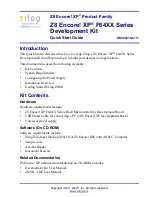C8051F36x-DK
Rev. 0.1
3
Keil 8051 Tools Into the Silicon Labs IDE”
in the “
SiLabs\MCU\Documentation\Appnotes
” directory on the CD-
ROM for additional information on using the Keil 8051 tools with the Silicon Laboratories IDE.
To build an absolute object file using the Silicon Laboratories IDE project manager, you must first create a project.
A project consists of a set of files, IDE configuration, debug views, and a target build configuration (list of files and
tool configurations used as input to the assembler, compiler, and linker when building an output object file).
The following sections illustrate the steps necessary to manually create a project with one or more source files,
build a program and download the program to the target in preparation for debugging. (The IDE will automatically
create a single-file project using the currently open and active source file if you select
Build/Make Project
before a
project is defined.)
4.4.1. Creating a New Project
1. Select
Project
→
New Project
to open a new project and reset all configuration settings to default.
2. Select
File
→
New File
to open an editor window. Create your source file(s) and save the file(s) with a rec-
ognized extension, such as .c, .h, or .asm, to enable color syntax highlighting.
3. Right-click on “New Project” in the
Project Window
. Select
Add files to project
. Select files in the file
browser and click Open. Continue adding files until all project files have been added.
4. For each of the files in the
Project
Window
that you want assembled, compiled and linked into the target
build, right-click on the file name and select
Add file to build
. Each file will be assembled or compiled as
appropriate (based on file extension) and linked into the build of the absolute object file.
Note:
If a project contains a large number of files, the “Group” feature of the IDE can be used to organize.
Right-click on “New Project” in the
Project Window
. Select
Add Groups to project
. Add pre-defined
groups or add customized groups. Right-click on the group name and choose
Add file to group
. Select files
to be added. Continue adding files until all project files have been added.
4.4.2. Building and Downloading the Program for Debugging
1. Once all source files have been added to the target build, build the project by clicking on the
Build/Make
Project
button in the toolbar or selecting
Project
→
Build/Make Project
from the menu.
Note:
After the project has been built the first time, the
Build/Make Project
command will only build the
files that have been changed since the previous build. To rebuild all files and project dependencies, click
on the
Rebuild All
button in the toolbar or select
Project
→
Rebuild All
from the menu.
2. Before connecting to the target device, several connection options may need to be set. Open the
Connection Options
window by selecting
Options
→
Connection Options...
in the IDE menu. First, select
the appropriate adapter in the “Serial Adapter” section. Next, the correct “Debug Interface” must be selected.
C8051F36x family devices use the Silicon Labs 2-wire (C2) debug interface. Once all the selections are
made, click the OK button to close the window.
3. Click the
Connect
button in the toolbar or select
Debug
→
Connect
from the menu to connect to the device.
4. Download the project to the target by clicking the
Download
Code
button in the toolbar.
Note:
To enable automatic downloading if the program build is successful select
Enable automatic con-
nect/download after build
in the
Project
→
Target Build Configuration
dialog. If errors occur during the
build process, the IDE will not attempt the download.
5. Save the project when finished with the debug session to preserve the current target build configuration,
editor settings and the location of all open debug views. To save the project, select
Project
→
Save Project
As...
from the menu. Create a new name for the project and click on
Save
.


















